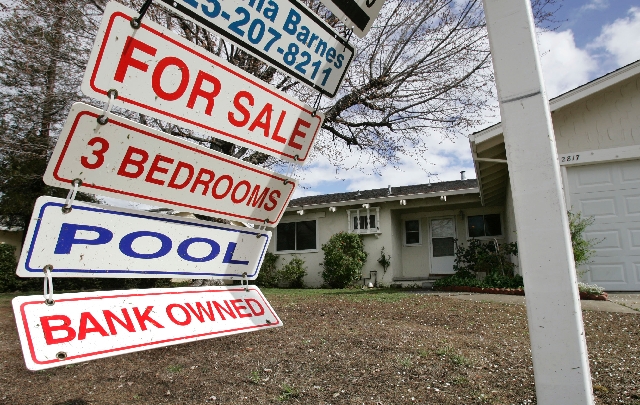Nevada joins trend as home foreclosures fall to five-year low nationwide

LOS ANGELES — The number of U.S. homes repossessed by lenders last month fell to the lowest level in more than five years, the latest evidence that the nation’s foreclosure crisis is abating amid an improving housing market.
While some states still saw increases in homes taken back by banks, nationally home repossessions fell 1 percent in March from the previous month and were down 23 percent from a year earlier, foreclosure listing firm RealtyTrac Inc. said Thursday.
Thirty-four states posted annual declines in completed foreclosures, including Nevada, which was down 55 percent. States bucking the national trend included Arkansas, Maryland, Washington, Pennsylvania and Ohio.
All told, lenders repossessed 43,597 homes last month, the lowest level since September 2007.
At the current monthly pace, completed foreclosures will total roughly 550,000 this year, down from 671,000 last year, RealtyTrac said.
An uptick in homes that entered the foreclosure process last month, however, may end up pushing that total to 600,000, said Daren Blomquist, a vice president at RealtyTrac.
Several factors are contributing to the decline in completed foreclosures: Steady job growth and ultra-low mortgage rates are helping the once-battered housing market recover, driving demand for homes and prices upward.
Higher home values help restore equity to homeowners, which can help those at risk of foreclosure by improving their chances of refinancing their mortgage to a lower payment or place them in a better position to sell their home.
Meanwhile, California, Nevada and other states have passed laws to increase homeowners’ protections from foreclosure. Those laws have effectively delayed the pace of homes entering the foreclosure process, which has helped to thin the pipeline of completed foreclosures in those states.
Even so, the number of foreclosure starts, or homes that entered the foreclosure process, edged higher for the second month in a row in March. And Nevada was among the states leading that charge.
Foreclosure starts rose 2 percent from February to 73,113. That’s still down 28 percent from March last year, RealtyTrac said.
Nevada was among 12 states that saw annual increases in foreclosure starts last month.
The Silver State experienced an 88 percent increase from a year ago, which is seemingly modest compared to the triple-digit upticks some states saw, including New York’s 200 percent increase and Maryland’s 193 percent increase.
Overall Nevada foreclosure activity increased 13 percent in the first quarter compared to the previous quarter, helping the state post the nation’s second-highest foreclosure rate in the first quarter of 2013. One in every 115 Nevada housing units had a foreclosure filing during the quarter.
First quarter foreclosure activity in Nevada was still down 18 percent from a year ago, but the quarterly increase was driven largely by a recent uptick in foreclosure starts.
During the housing downturn, about half of the homes that entered the foreclosure process ended up as bank-owned homes that could potentially be sold at a sharp discount, hurting the value of nearby homes.
But with the housing market apparently on a sustained, if gradual, turnaround path, it’s more likely that a home entering the foreclosure process now will be able to avoid being lost to foreclosure, Blomquist said.
“A lot of these won’t end up as vacant bank-owned homes, dragging down the market,” he said. “These foreclosures are happening in the context of a housing market that’s recovering. They’re not a sign that the housing market is going downhill again.”
As of the end of March, there were about 1.5 million U.S. homes in some stage of foreclosure, with 623,697 owned by lenders, according to RealtyTrac. That’s down from a peak of 2.2 million in December 2010.
In Clark County, there were 1,864 bank-owned properties during the first quarter, compared to 4,742 in first quarter 2012.
Most of the homes on the foreclosure path have loans that were made during the housing boom years and early into the downturn.
As of December, 75 percent of homes in some stage of foreclosure have loans that were originated between 2003 and 2008, while 11 percent were made before 2003. Only 14 percent of the loans were made after 2009, the firm said.
The latest data show homes that do complete the foreclosure process are taking longer to do so.
On average, homes that completed the foreclosure process in the first three months of the year took an average of 477 days to do so, up from an average of 370 days in the same period last year, RealtyTrac said.
New York ranked as the state with the longest foreclosure timeline at 1,049 days, or just under three years.
Texas registered the fastest foreclosure process, taking an average of 159 days, the firm said.
Review-Journal writer Laura Carroll contributed to this report.